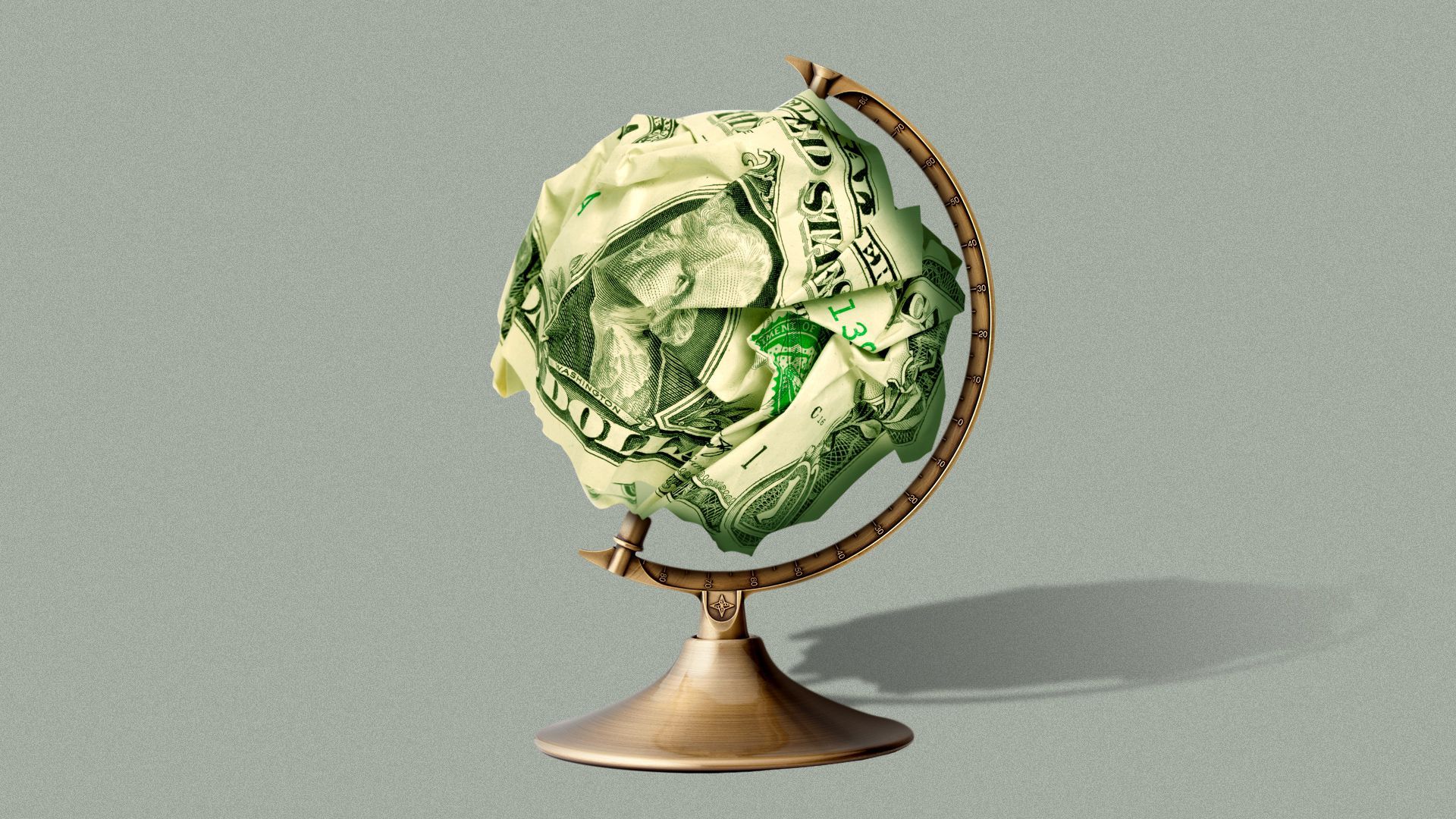| | | | | | | Presented By Raytheon Technologies | | | | Axios Markets | | By Dion Rabouin ·Dec 07, 2020 | | Good morning! Was this email forwarded to you? Sign up here. (Today's Smart Brevity count: 968 words, <4 minutes.) 🖥 Join Axios tomorrow at 12:30pm ET for a virtual event on the future of health care payments featuring NEA's Mohamad Makhzoumi and Cedar's Florian Otto. Register here. 🎙 "All art is propaganda. ... The only difference is the kind of propaganda." — See who said it and why it matters at the bottom. | | | | | | 1 big thing: The world has a weak dollar problem |  | | | Illustration: Aïda Amer/Axios | | | | Even after sinking by 13% since its March peak and coming off its worst week in a month, the dollar's downward spiral has gone largely unmentioned by central banks. But that could change as the values of many major currencies have strengthened to their highest levels in years against the greenback. Why it matters: The dollar's decline could add significant challenges to the recovery of export-oriented economies like the eurozone and Japan, which prefer weaker currencies that make their products more attractive to foreign buyers. - And while the dollar's dive has helped rally stocks in emerging countries, those that are dependent on exports could see a slowdown in their growth because of their newly strong currencies.
By the numbers: The dollar is near its weakest level in over a year against at least 17 currencies, according to calculations from Deutsche Bank, including eight of the G10 currencies. - The Taiwan dollar and Israeli shekel recently hit their strongest levels against the dollar in more than 23 years and 12 years, respectively.
The big picture: Like the rally in equity markets, the bottom falling out on the dollar looks to be based on exuberance about the development of COVID-19 vaccines leading to stronger economic growth globally in 2021. (And of course the market backstop from the Fed in the form of unprecedented bond buying and negative real interest rates.) - But Juan Perez, senior FX trader and strategist at Tempus Inc, tells Axios in an email that he worries the weak dollar trade already may be "a bit overdone" as markets are looking past significant risks, including possible hiccups in the development and rollout of the vaccines, a hard Brexit and continued anxiety in Europe.
- "So many risk items to watch, it'll make ya head spin."
State of play: Asset managers have built record short positions against the dollar, Bloomberg reported, citing CFTC data from the week ending Nov. 24. Bloomberg also notes... - Credit Suisse has forecast the euro will rise to $1.25 by the end of 2021.
- Goldman Sachs Asset Management has called for shorting the dollar against the Chinese yuan along with further gains in the euro and yen.
- Morgan Stanley and Citigroup have both recently forecast a weaker greenback.
The last word: "What breaks this chain?" asks Deutsche Bank macro strategist Alan Ruskin. - "Usually it has to come from US fundamentals, although in the current instance, it likely needs some break to the extraordinary risk positive momentum, if not from news flow, then via evidence that risk is overpositioned and bellwethers like the S&P are no longer responding to good news."
|     | | | | | | 2. Catch up quick | | Airbnb is raising the price range on its IPO to between $56 and $60 a share, from $44 to $50, giving the home-rental company a valuation of as much as $42 billion on a fully diluted basis. (WSJ) Every American will be able to get a coronavirus vaccine by the second quarter of 2021, Health and Human Services Secretary Alex Azar said in an interview for "Axios on HBO." (Axios) A group of Democratic and Republican senators could unveil a new fiscal stimulus bill as early as today worth around $908 billion, but its unclear whether Senate Majority Leader Mitch McConnell will allow it to go forward for a vote. (FT) Walmart is preparing to sell approximately 25% of its stake in India's Flipkart with an IPO through Goldman Sachs, according to anonymous sources. (Mint) |     | | | | | | 3. Jobs report shows "creative destruction" has begun |  Data: BLS. Chart: Axios Visuals Friday's jobs report was weaker than expected, showing a gain of 245,000 jobs — far short of the expected 450,000 and further short of October's 610,000 — and painted perhaps the clearest picture yet of the seismic shift happening to the U.S. labor market. What happened: While the headline number was disappointing, the report's most telling negative was the decrease in labor force participation and the increase of 400,000 people who said that they wanted to work but did not look for a job during the month. - There were 10 million fewer people employed in November than there were in February and at November's pace of jobs growth it will take three years to return to February's employment level.
Don't sleep: "If you want to watch only one indicator to get a sense of what long-term damage the COVID crisis is likely to do to the economy, this is the indicator to watch," AllianceBernstein senior economist Eric Winograd said of labor force participation. - "The more people who permanently leave the labor force, the bigger the headwind to longer-term growth, and those who are currently out of work increasingly report that their layoffs are permanent rather than temporary."
Permanent job losers accounted for 35% of the 10.7 million unemployed in November and ratings agency S&P Global does not expect U.S. employment to reach its February levels until 2023. The big picture: "Economies are not going back to their pre-COVID-19 configuration," S&P Global chief economist Paul Gruenwald said in a recent report. "[T]he composition of output will change and this process has already begun." - "As a result, new firms are starting to form in growth sectors (and exit shrinking ones) and workers are starting to move toward these growth sectors (and away from the shrinking ones), in what is known as 'creative destruction.'"
|     | | | | | | A message from Raytheon Technologies | | The future of aerospace and defense is here | | |  | | | | At Raytheon Technologies, nearly 200,000 engineers, scientists and researchers are pushing the limits of known science to explore deep space, advance aviation and build smarter defense systems that protect all of us here at home. That's the future of aerospace and defense. Learn more at RTX.com | | | | | | 4. Economists get more bullish on 2021 U.S. growth | | A group of top economists have perked up their expectations for U.S. growth next year, predicting the economy will bounce back to its 2019 level earlier than expected. What's happening: The National Association for Business Economics released its latest outlook showing 73% of panelists believe that the economy will have returned to pre-pandemic GDP levels by the second half of 2021. - That's a notable improvement from August when more than 60% of the group's economists predicted U.S. GDP would remain below its 2019 level until at least 2022, with nearly 50% expecting the rebound wouldn't happen until the second quarter.
- Just 18% now expect it will take until the first half of 2022 for the economy to reach its 2019 size.
What they're saying: "NABE panelists have become more optimistic, on balance, with nearly one-third revising their outlook higher based on recent news of effective vaccines," NABE survey chair Holly Wade said in a statement. - "Just over one-third of respondents anticipate more downside risk to economic growth in 2021," said Wade, executive director at NFIB Research Center.
- "Panelists point to a second wave of COVID-19 cases as their main concern."
|     | | | | | | A message from Raytheon Technologies | | The future of aerospace and defense is here | | |  | | | | At Raytheon Technologies, nearly 200,000 engineers, scientists and researchers are pushing the limits of known science to explore deep space, advance aviation and build smarter defense systems that protect all of us here at home. That's the future of aerospace and defense. Learn more at RTX.com | | | | Thanks for reading! Quote: "All art is propaganda. ... The only difference is the kind of propaganda." Why it matters: On Dec. 7, 1940, artist Diego Rivera married fellow artist Frida Kahlo for the second time after their divorce in 1939. | | | | Axios thanks our partners for supporting our newsletters.
Sponsorship has no influence on editorial content. Axios, 3100 Clarendon Blvd, Suite 1300, Arlington VA 22201 | | | You received this email because you signed up for newsletters from Axios.
Change your preferences or unsubscribe here. | | | Was this email forwarded to you?
Sign up now to get Axios in your inbox. | | | | Follow Axios on social media:    | | | | | |






No comments:
Post a Comment